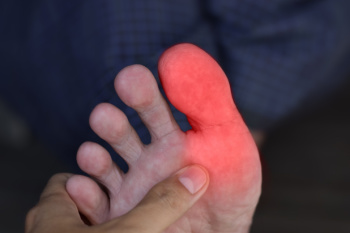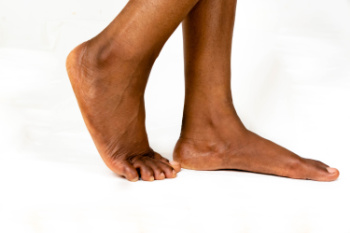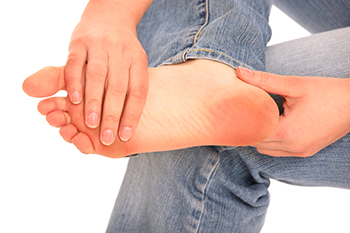Items filtered by date: August 2024
Causes and Risk Factors for Turf Toe

Turf toe is an injury that affects the metatarsophalangeal, or MTP joint, located at the base of the big toe. It occurs when the big toe is forced into an overextended position, leading to damage in the plantar complex, which consists of ligaments, tendons, and small bones. Turf toe is common among dancers, athletes who play on artificial surfaces, and those who engage in martial arts. The severity of turf toe varies, with symptoms ranging from mild pain and swelling to severe tenderness, bruising, and an inability to bear weight on the affected foot. Risk factors include wearing lightweight, flexible shoes and engaging in activities on artificial turf. Imaging is often used to confirm the diagnosis of turf toe, identify any additional injuries, and assess the severity of the MTP sprain. If you are experiencing pain beneath the big toe joint, it is suggested that you schedule an appointment with a chiropodist for a diagnosis and appropriate treatment options.
Toe pain is common and can have a variety of causes. Causes can range from a broken toe to an ingrown toenail. Many types of toe pain can be corrected, but any toe pain that inhibits your activities for an extended period should be discussed with a chiropodist. If you suffer from toe pain, please consult with Emily Yu, B.Sc from Uptown Foot Care Clinic. Our specialist can help you maintain the health of your feet.
Common Causes of Toe Pain
- Trauma or fracture
- Cuts, sores, or bruises
- Rheumatoid arthritis
- Gout
- Turf Toe
- Morton’s neuroma
- Blisters
- Corns
- Bunions
- Hammertoes
- Ingrown toenails
- Plantar warts
- Athlete’s Foot
Symptoms of Toe Pain
- Toe deformity
- Burning
- Numbness
- Toenail deformity
- Wart or ulcer
- Swelling
- Redness
When to See a Chiropodist
- Bleeding or severe swelling
- Trauma, such as a broken bone
- Discoloration or extreme swelling
- Inability to bear weight
- Persistent pain
- Wounds that won’t heal
Diagnosis of Toe Pain
A chiropodist can conduct a thorough examination of the painful toe or toes in order to determine the best course of treatment. The exam may include assessing the tenderness of the area, taking an X-ray or other diagnostic test, or assessing your gait and range of motion. A discussion of what led to the advanced pain issue may follow. Included will likely be a health history, as well as a list of medications you are taking and other previous injuries you may have sustained.
Treatment for Toe Pain
With such a wide range of possible causes for toe pain, treatment can be varied in scope and length. Sometimes, the chiropodist will recommend lifestyle and activity changes. In cases of trauma or other injuries, X-rays or imaging tests will likely be used to determine the severity of the problem, particularly if any bones have been broken. Treatment may also include injections of pain-relief medication or anti-inflammatory drugs. Certain injuries will require the splinting, bracing, or wrapping of injured toes. Orthotics or special shoes may be prescribed in cases of bone deformities and gait issues. Removal of warts, calluses, and corns may be needed. In other cases, such as with patients who have diabetes or rheumatoid arthritis, ongoing treatment may be required to avoid more serious problems.
Types of Flat Feet

Flat feet, or fallen arches, occur when the entire sole is nearly or completely in contact with the ground when you stand, resulting in little to no arch. The two main types of flat feet are flexible and rigid. In flexible flatfoot, the arch is visible while not bearing weight but disappears when standing. It often appears in childhood and may not cause problems. In contrast, rigid flatfoot, or adult-acquired flatfoot, involves a persistent lack of arch due to posterior tibial tendon dysfunction. Symptoms include pain and swelling, eventually leading to arthritis if untreated. Causes of flat feet range from congenital factors to obesity and diabetes. Symptoms can include foot pain, fatigue, and misaligned gait. A chiropodist can diagnose flat feet through a physical exam and imaging tests before offering such treatments as custom orthotics. If you have foot pain related to flat feet, it is suggested that you schedule an appointment with a chiropodist for an exam and treatment options.
Flat feet are a common foot condition. If you are experiencing pain or discomfort due to flat feet, please consult with Emily Yu, B.Sc from Uptown Foot Care Clinic. Our specialist will assess your condition and provide you with quality foot and ankle treatment.
What Are Flat Feet?
Flat feet are feet that do not have a well-defined arch in the middle of the sole of the foot. Flat feet may be flexible or rigid. Flexible flat feet have an arch when there is no pressure put on the foot, such as when one is sitting, but the arch disappears upon standing. Rigid flat feet lack an arch regardless of whether one is standing or not.
Causes
Flat feet can be present from birth or acquired over time due to a weakening of the ligaments in the arch. Sometimes flat feet are caused by illnesses, injuries, or pregnancy.
Symptoms
Flat feet often cause no noticeable symptoms. However, some people may experience pain and discomfort due to their flat feet.
Symptoms associated with flat feet include:
Pain in the arch, heel, ankle, or along the outside of the foot
Overpronation of the foot
Shin splints
Aching or fatigue in the feet or legs
Pain in the knees, hips, or lower back
Treatment
In cases where flat feet cause symptoms, there are various treatments available. Wearing orthotic inserts in your shoes to provide more arch support, performing stretches, and taking medications may improve your symptoms. If you are overweight, losing weight can help relieve pressure on the feet. In severe cases, surgery may be considered.
If you have any questions, please feel free to contact our office located in . We offer the newest diagnostic and treatment technologies for all your foot care needs.
Gout Pain Can Be Managed
Causes of Pain in the Ball of the Foot

Pain in the ball of the foot, known as metatarsalgia, can stem from a variety of sources. High-impact activities like running or jumping can put excessive pressure on the metatarsal bones, leading to inflammation and pain. Wearing shoes that lack proper support or have high heels can also contribute to this condition. Other factors for metatarsal foot pain include foot deformities such as hammertoes or bunions, obesity, and medical conditions like arthritis or diabetes. A chiropodist can diagnose the underlying cause of metatarsalgia through a detailed examination and imaging studies. Relief may include custom orthotics to provide better arch support, or corticosteroid injections to reduce inflammation. If you have pain in the ball of your foot, it is suggested that you schedule an appointment with a chiropodist for a diagnosis and treatment options.
Foot pain can have many causes. To receive an accurate diagnosis and treatment for your foot pain, please consult with Emily Yu, B.Sc from Uptown Foot Care Clinic. Our specialist will assess your condition and provide you with quality foot and ankle treatment.
Causes
There are a variety of different conditions that can cause foot pain, including:
Plantar fasciitis
Deformities, such as bunions or hammertoes
Injuries to the muscles, bones, tendons, or ligaments in the feet
Arthritis
Flat feet
Ingrown toenails
Symptoms
The type and location of your foot pain can help determine what may be causing it and what type of treatment options are best for you.
Common types of foot pain include:
Heel pain
Arch pain
Toe pain
Ball of foot pain
Pain that has a stabbing, burning, or tingling quality
Pain that is constant, intermittent, or that gets better or worse depending on the situation
Diagnosis
A thorough medical history and physical examination of your feet will be required to determine a diagnosis. Imaging studies, such as X-rays or MRIs may be performed to rule out or confirm certain diagnoses.
Treatment
Treatment will depend on the cause of the pain. Common treatments for foot pain include resting, icing, compressing, and elevating the affected foot, wearing orthotics, or taking anti-inflammatory medications.
If you have any questions, please feel free to contact our office located in . We offer the newest diagnostic and treatment technologies for all your foot care needs.
Foot Issues From Playing Pickleball

Pickleball, a fast-growing sport that combines elements of tennis, badminton, and table tennis, can lead to various foot problems due to its quick movements and sudden changes in direction. Common issues include plantar fasciitis, which causes heel pain from inflammation of the plantar fascia. It can be the result of repetitive impact from playing on hard pickleball courts. Ankle sprains are also prevalent due to the rapid lateral movements, leading to overstretched or torn ligaments. Metatarsalgia, or pain in the ball of the foot, can occur from the constant pivoting and quick stops. Proper footwear with good arch support and cushioning is essential to prevent these injuries. Stretching before and after playing helps maintain flexibility and reduce the risk of strains. Using orthotics can provide additional support and alignment. If you enjoy playing pickleball but have persistent foot pain, it is suggested that you schedule an appointment with a chiropodist for a proper diagnosis and treatment.
Injuries to the foot and ankle are very common among athletes. If you have experienced an injury, please consult with Emily Yu, B.Sc from Uptown Foot Care Clinic. Our specialist will assess your condition and provide you with quality foot and ankle treatment.
Common Injuries Among Athletes:
Achilles tendon injuries
Ankle strains or sprains
Plantar fasciitis
Fractures
Turf toe
Joint dislocations
Sever’s disease
Morton’s neuroma
Symptoms
Symptoms will depend on the cause and severity of the injury. Common symptoms for a foot or ankle injury include pain, swelling, tenderness, bruising, a reduced range of motion, and difficulty bearing weight or walking on the affected foot or ankle.
Diagnosis
Sports injuries are typically diagnosed after carefully examining the affected foot or ankle. This includes moving the injured area to test its range of motion. Medical history will need to be provided, as well as detailed information about how the injury occurred. Imaging studies, such as X-rays or MRIs, may be used to confirm or rule out certain diagnoses.
Treatment
Just like symptoms, treatment will depend on the type of injury and its severity. Initial treatment for many sports injuries is aimed at controlling inflammation and promoting the healing response. The acronym R.I.C.E is a helpful guide to implement for most acute injuries. This method involves resting, icing, compressing, and elevating the affected foot or ankle. In addition, anti-inflammatory medications may be administered and orthotic devices may be prescribed. For more severe injuries, surgery may be required. Lastly, rehabilitation or physical therapy may be needed to gain full functionality in the afflicted area.
If you have any questions, please feel free to contact our office located in . We offer the newest diagnostic and treatment technologies for all your foot care needs.

